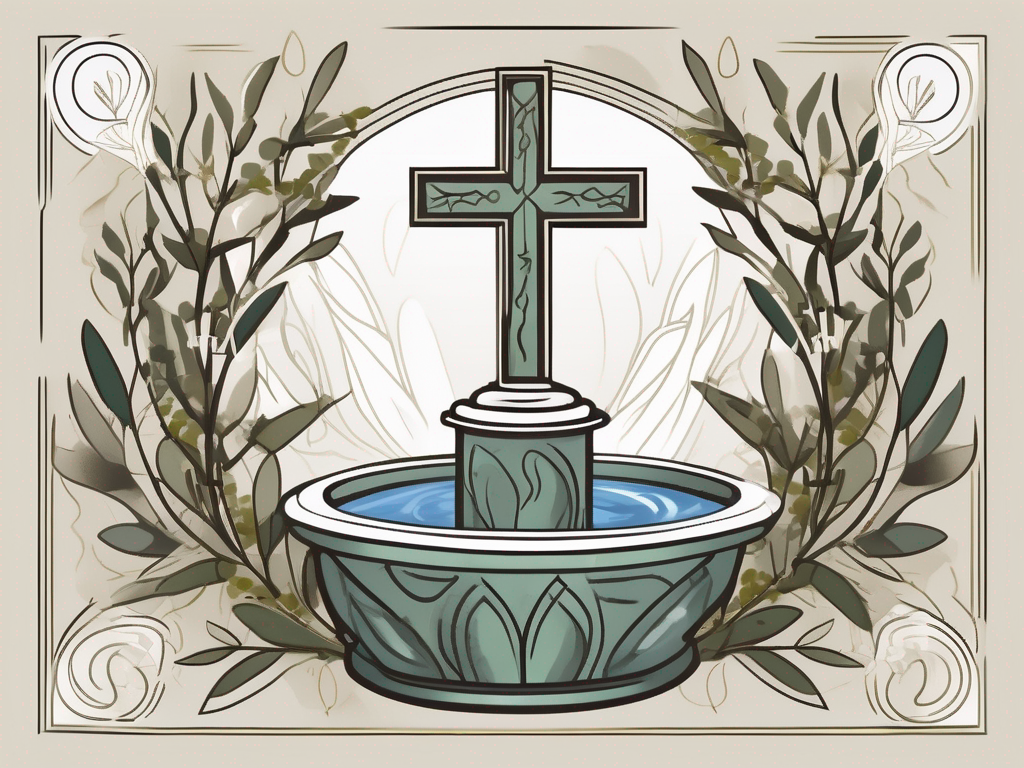Baptism in water is an important ritual in Christianity that symbolizes a believer’s commitment to their faith. In this comprehensive guide, we will explore the meaning of baptism, its theological significance, the process involved, and answer frequently asked questions about this sacred ceremony.
Understanding the Concept of Baptism
Before delving into the details, it’s crucial to grasp the concept of baptism. Baptism is a sacrament that symbolizes the believer’s identification with Jesus Christ’s death, burial, and resurrection. It serves as an outward expression of an individual’s inward faith and repentance.
The Origin and History of Baptism
The practice of water baptism has roots in ancient Jewish purification rituals. In the Old Testament, we find references to various forms of ritual cleansing, such as the washing of hands and feet before entering the temple. These acts were seen as symbolic of purification and preparation to approach God.
In the New Testament, we find accounts of John the Baptist baptizing people in the Jordan River, preparing the way for Jesus. John’s baptism was a call to repentance and a symbol of cleansing from sin. It was a powerful and transformative experience for those who participated.
After Jesus’ death and resurrection, baptism took on a new meaning in the early Christian church. It became a way for believers to publicly declare their faith in Jesus and their commitment to follow Him. The apostle Peter, in his sermon on the day of Pentecost, urged the people to “repent and be baptized, every one of you, in the name of Jesus Christ for the forgiveness of your sins” (Acts 2:38).
The Symbolism Behind Water Baptism
Water baptism holds profound symbolism. Immersion in water signifies the believer’s identification with Christ’s burial, while emerging from the water represents their resurrection to newness of life. It is a tangible representation of dying to the old self and being born again in Christ.
Just as Jesus died and was buried, so the believer, through baptism, symbolically dies to their old way of life and is buried with Christ. And just as Jesus rose from the dead, so the believer, through baptism, rises to a new life in Christ. It is a powerful visual representation of the believer’s union with Christ and their participation in His death and resurrection.
Furthermore, water itself has symbolic significance in various religious traditions. It is often associated with purification, cleansing, and renewal. In baptism, water is not only a physical element but also a spiritual symbol of the believer’s cleansing from sin and their new life in Christ.
Different Christian Views on Baptism
Within Christianity, there are variations in beliefs regarding baptism. Some traditions emphasize baptism as a necessary means of salvation, viewing it as a sacrament that imparts grace and washes away original sin. They believe that baptism is essential for salvation and that without it, one cannot enter into the fullness of the Christian faith.
On the other hand, there are those who view baptism primarily as a public declaration of faith. They see it as an act of obedience and a way for believers to publicly proclaim their commitment to follow Jesus. While they recognize the importance of baptism, they do not believe it is necessary for salvation.
Understanding these different perspectives can provide a comprehensive view of the significance of baptism across various Christian denominations. It highlights the diversity within the body of Christ and the different ways in which believers express their faith and understanding of this sacred sacrament.
The Theological Significance of Baptism
Beyond its symbolism, baptism also holds theological significance within the Christian faith. Let’s explore its role in the New Testament, its connection to salvation, its relation to the Holy Spirit, and the rich history of baptismal practices.
Baptism in the New Testament
In the New Testament, we encounter numerous references to baptism. It was a practice initiated by Jesus himself, who commanded his disciples to baptize believers. The apostles and early Christians viewed baptism as a vital part of the Christian journey and obedient response to Jesus’ teachings.
One of the most well-known accounts of baptism in the New Testament is the baptism of Jesus by John the Baptist in the Jordan River. This event marked the beginning of Jesus’ public ministry and symbolized his identification with humanity and his willingness to fulfill God’s plan of salvation.
Throughout the New Testament, baptism is portrayed as a public declaration of faith and a means of entering into the community of believers. It symbolizes the washing away of sins and the new life that comes through faith in Jesus Christ.
The Role of Baptism in Salvation
While some Christian traditions believe that baptism is necessary for salvation, most agree that it is a symbol of a person’s faith and repentance. It is important to note that baptism does not guarantee salvation, but rather serves as an outward expression of a transformed heart.
For those who view baptism as essential for salvation, it is seen as the moment when a person is united with Christ and receives the forgiveness of sins. It is believed to be a sacrament through which God’s grace is imparted to the individual.
Others see baptism as an important step in the process of salvation, but not the sole means of receiving God’s grace. They emphasize the importance of faith and the ongoing journey of discipleship as essential components of salvation.
Baptism and the Holy Spirit
Baptism is often associated with the infilling or baptism of the Holy Spirit. This is the belief that the Holy Spirit empowers and dwells in individuals after their baptism, equipping them for a life of faith and service. The relationship between baptism and the Holy Spirit varies among Christian denominations.
Some denominations teach that the baptism of the Holy Spirit is a separate experience from water baptism and is marked by the manifestation of spiritual gifts, such as speaking in tongues or prophesying. They believe that this baptism empowers believers for ministry and deepens their relationship with God.
Others view the baptism of the Holy Spirit as a simultaneous event with water baptism, emphasizing the transformative work of the Holy Spirit in the life of a believer. They see baptism as the moment when the Holy Spirit comes upon an individual, sealing them as a member of the body of Christ and empowering them for service.
The Rich History of Baptismal Practices
Beyond its theological significance, baptism has a rich history of diverse practices and traditions. Throughout the centuries, different cultures and Christian communities have developed unique rituals and customs surrounding baptism.
In some traditions, baptism is performed through immersion in water, symbolizing the burial and resurrection of Jesus Christ. Other traditions practice baptism by pouring or sprinkling water, emphasizing the cleansing and purifying aspects of the sacrament.
Historically, baptismal fonts and pools have been important architectural features in churches, often positioned near the entrance as a reminder of the believer’s entry into the community of faith. The design and decoration of these baptismal elements vary across different cultures and time periods, reflecting the artistic and religious sensibilities of the people.
Additionally, baptismal garments, such as white robes or gowns, have been used to symbolize the new life and purity that comes through baptism. These garments serve as a visual representation of the believer’s commitment to follow Christ and live a transformed life.
Throughout history, baptism has been a significant and meaningful practice in the Christian faith, uniting believers across denominational lines and reminding them of their identity as followers of Jesus Christ.
The Process of Baptism
Now that we have explored the meaning and theological significance of baptism, let’s take a closer look at the practical aspects of the baptism process.
Baptism is a sacred and symbolic act that holds deep meaning for Christians. It is not just a ritual but a profound expression of faith and commitment to Jesus Christ. The process of baptism involves several important steps that ensure its significance is understood and embraced by the individual seeking baptism.
The Preparation for Baptism
Baptism involves careful preparation. It is essential for individuals seeking baptism to understand its significance and undergo proper instruction, ensuring they have a genuine understanding of their faith commitment.
Preparation for baptism often includes attending baptism classes or meetings where candidates learn about the biblical basis of baptism, its historical significance, and its role in the life of a believer. These classes provide an opportunity for candidates to ask questions, deepen their understanding, and reflect on their personal faith journey.
Furthermore, candidates are encouraged to engage in self-reflection and introspection, examining their own spiritual journey and the reasons behind their desire to be baptized. This introspection helps individuals develop a personal connection with the sacrament and prepares them for the transformative experience that lies ahead.
The Baptism Ceremony: What to Expect
During the baptism ceremony, candidates are typically immersed in water, representing their identification with Jesus’ death and resurrection. The ceremony is often conducted by a minister or church leader and witnesses the believer’s public declaration of their faith in Christ.
The baptismal service is a sacred and joyous occasion, filled with symbolism and meaning. As the candidate enters the water, they are reminded of their spiritual death and burial with Christ, and as they emerge from the water, they are symbolically raised to new life in Christ, just as Jesus was resurrected from the dead.
The ceremony is often accompanied by prayers, hymns, and readings from the Bible, creating a reverent and worshipful atmosphere. Family, friends, and members of the church community gather to witness and celebrate this significant milestone in the candidate’s spiritual journey.
Post-Baptism: The Journey Continues
Baptism is not the end of the journey but rather the beginning. After baptism, believers are encouraged to grow in their faith, continue their spiritual journey, and actively participate in a community of fellow believers.
Following baptism, individuals are often welcomed into the church community with open arms. They are encouraged to join small groups or Bible studies, where they can deepen their understanding of the Scriptures, receive guidance and support from more experienced believers, and build meaningful relationships with fellow Christians.
Moreover, baptism serves as a reminder of the believer’s commitment to live a life that reflects the teachings and example of Jesus Christ. It is a call to walk in obedience to God’s Word, to love and serve others, and to be a witness of God’s grace and truth in the world.
As the journey continues, believers may face challenges and doubts, but baptism serves as a powerful reminder of their identity as a child of God and their participation in the larger story of God’s redemptive work in the world.
Frequently Asked Questions about Baptism
Now, let’s address some common queries that arise when discussing baptism.
Who Can Be Baptized?
In most Christian traditions, baptism is open to anyone who professes faith in Jesus Christ, regardless of age or background. Some churches practice infant baptism as a means of dedicating the child to God, while others baptize only adults or those who are old enough to express their personal faith.
Infant baptism, also known as paedobaptism, has been a subject of theological debate for centuries. Proponents argue that it is a way to include children in the covenant community from an early age, while critics raise concerns about the validity of a baptism performed before an individual can fully understand and profess their faith.
On the other hand, adult baptism, also known as believer’s baptism or credobaptism, emphasizes the importance of a personal confession of faith. It is seen as a conscious decision made by an individual who has reached an age of understanding and is able to make a commitment to follow Jesus.
Why is Baptism Important?
Baptism holds great significance in the life of a Christian. It symbolizes a commitment to following Jesus, publicly declaring one’s faith, and participating in a community of believers. It is an act of obedience, an expression of faith, and a powerful moment of spiritual transformation.
Through baptism, Christians identify with the death, burial, and resurrection of Jesus Christ. Just as Jesus died and rose again, believers symbolically die to their old way of life and are raised to new life in Christ. It is a visible representation of the inward change that occurs when someone accepts Jesus as their Lord and Savior.
Baptism is also a communal act. It signifies joining a community of believers, the Church, and participating in the body of Christ. It is a public proclamation of one’s faith and an invitation to others to join in the journey of discipleship.
Can Baptism Be Repeated?
While most Christian traditions believe that baptism is a one-time event, some individuals may choose to be baptized again if they feel their initial baptism did not fully demonstrate their commitment to Christ. This practice is often referred to as “rebaptism” or “renewal of baptism.”
Rebaptism is more common among those who have experienced a significant spiritual transformation or a renewed commitment to their faith. It is seen as a way to publicly acknowledge and reaffirm one’s faith in Jesus Christ.
However, the question of rebaptism is not without controversy. Some argue that baptism is a once-and-for-all sacrament, and repeating it undermines the theological understanding of its significance. Others believe that rebaptism is a valid expression of personal faith and a way to mark a new chapter in one’s spiritual journey.
In conclusion, water baptism carries deep meaning within the Christian tradition. It serves as a powerful symbol of faith, repentance, and new life in Christ. Understanding its theological significance, participating in the baptism process, and engaging with the common questions surrounding baptism can lead to a more comprehensive understanding of this sacred rite.












